MakerBot Industries
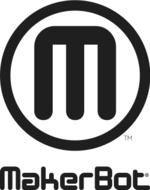 | |
| Industry | 3D printing |
|---|---|
| Founded | January 2009 |
| Founder | Bre Pettis, Adam Mayer, and Zach "Hoeken" Smith |
| Headquarters | New York City (Brooklyn), United States |
Key people | Jonathan Jaglom (CEO) |
| Products | Cupcake, Thing-O-Matic, Replicator, Replicator 2, Replicator 2x, Z18 |
Number of employees | ca. 400 (2015) |
| Parent | Stratasys |
| Website |
www |
MakerBot Industries is a New York City-based company founded in January 2009 by Bre Pettis, Adam Mayer and Zach "Hoeken" Smith to engineer and produce 3D printers. MakerBot builds on the early progress of the RepRap Project. As of April 2015, following a layoff of around 20% of its staff, MakerBot has about 400 employees.[1]
History

Smith was one of the founding members of the RepRap Research Foundation,[2] a non-profit group created to help advance early research in the area of open-source 3D printers.[3] Bre Pettis got inspired during an art residency in Vienna with Johannes Grenzfurthner/monochrom in 2007, when he wanted to create a robot that could print shot glasses for the event Roboexotica and did research about the RepRap project at the Vienna hackerspace Metalab.[4] Shot glasses remained a theme throughout the history of MakerBot.[5]
The company started shipping kits in April 2009 and had sold approximately 3,500 units as of March 2011. Demand for the kits was so great in 2009 that the company solicited MakerBot owners to provide parts for future devices from their own MakerBots.[6] Seed funding of $75,000 was provided by Jake Lodwick ($50,000) and Adrian Bowyer and his wife, Christine ($25,000).[7]
In August 2011, venture capital firm The Foundry Group invested $10 million in the company and joined its board.[8]
On June 19, 2013, Stratasys Incorporated announced that it had acquired MakerBot in a stock deal worth $403 million,[9] based on the current share value of Stratasys. The deal provided that MakerBot would operate as a distinct brand and subsidiary of Stratasys, serving the consumer and desktop market segments.[10] Bre Pettis moved to a position at Stratasys and was replaced as CEO by Jenny Lawton, who in 2015 was succeeded by Jonathan Jaglom.[1]
In April 2015, it was reported that in an effort to integrate MakerBot's activities better with those of Stratasys, Jaglom laid off around 100 of 500 employees and closed the existing three MakerBot retail locations.[1]
Products
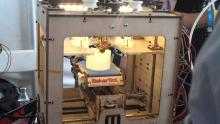
MakerBot Industries' products were designed to be built by anyone with basic technical skills and were described as about as complicated as assembling IKEA furniture.[11] The first printers were sold as do it yourself kits, requiring only minor soldering, but later models were designed as closed-box products, with little or no user customization or construction.
MakerBot printers print with acrylonitrile butadiene styrene (ABS), high-density polyethylene (HDPE), polylactic acid (PLA), and polyvinyl alcohol (PVA).
Cupcake CNC
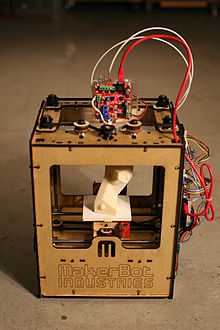
The Cupcake CNC was introduced in April 2009. The source files needed to make the devices were put on Thingiverse, allowing anyone to build their own from scratch. The Cupcake CNC features a usable build area of 100.0 by 100.0 by 130.0 mm (L/W/H) and has outside dimensions of 350.0 by 240.0 by 450.0 mm.[12]
Because of the open source nature of the product, many suggestions for improvements came from users. Printing upgrades and replacement parts became popular projects for learning to operate the units. During its primary production run (April 2009 to September 2010), the Cupcake CNC had numerous upgrades so each 'batch' of new units was upgraded. The early model Cupcake CNC units shipped with a Plastruder MK3 and both acrylic and foamcore build platforms. All Cupcake CNC units shipped with DC motor extruders and Generation 3 electronics. Serial numbers for Cupcake CNC printers start at #1 and end around #2625.
Thing-O-Matic
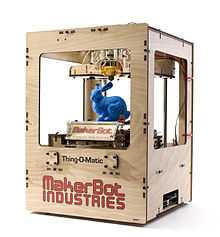
Introduced in September 2010 at Maker Faire NYC, the Thing-O-Matic was MakerBot's second kit. It shipped with many of the common upgrades that had been built for Cupcake. The stock Thing-O-Matic included a heated, automated build platform, an MK5 plastruder, a redesigned z-stage and upgraded electronics (Generation 4). Later batches shipped with an MK6 Stepstruder, a stepper motor-based extruder as well as the parts to print using smaller 1.75 mm filament stocks.[12]
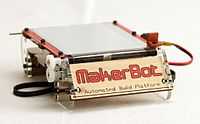

Parts were fabricated using acrylonitrile butadiene styrene (ABS) or polylactic acid (PLA) with an extrusion head with z axis mobility and a platen with x and y axis mobility. Fully assembled, the exterior dimensions are 300.0 by 300.0 by 410.0 mm (12.0″ W × 12.0″ D × 16.0″ H) with a build envelope of 100.0 by 100.0 by 100.0 mm (4.0″ W × 4.0″ D × 4.0″ H) when using the automated build platform. The device interfaces via USB or a Secure Digital (SD) card.
The Thing-O-Matic was discontinued in the spring of 2012.[14] Makerbot Industries agreed to support the Thing-o-Matic until their supply of parts was exhausted. Thing-O-Matic serial numbers start at #3000 and as of March 2011 were up to approximately 3850. The use of an automatic build platform is unique to the Thing-O-Matic. This component allows for the user to queue items to print, printing and ejecting each in turn after cooldown. This gives the printer the capability to execute a queue of print jobs unattended. In some configurations base layer material does not adhere well to the plastic belt surface. It has been proposed[15] that using a titanium belt could fix this issue. Other users simply use the heated build platform and print on a layer of masking tape (specifically blue painters tape) or kapton tape.
Instructions for assembly are provided online through the Makerbot Wiki.[16] The Thing-O-Matic is open-source hardware and is licensed under the GNU GPLv3. As such, the Thing-O-Matic can be heavily altered and improved by users.
Some MakerBot operators developed upgrades to the platform that were later incorporated into factory kits. MakerBot has credited those early innovators in their documentation,[17] and even on some of the PCB silkscreen layouts.[18]
Replicator
In January 2012 Makerbot introduced the Replicator. It offered more than double the build envelope of the Thing-o-Matic (225.0 by 145.0 by 150.0 mm or 8.9 x 5.7 x 5.9 in). Other features included a dual extruder allowing two-color builds and upgraded electronics that include an LCD display and a control pad for direct user interaction without the need for a PC. The replicator is offered pre-assembled, with no kit version. It was the last open-source Makerbot printer; later models increasingly use proprietary technology, rendering them incompatible with many open-source programs.
Replicator 2 Desktop 3D Printer
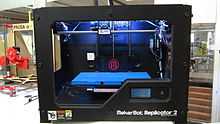
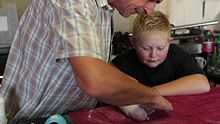
In September 2012, Makerbot Industries introduced the Replicator 2. The new version 3D printer again increased the build envelope (285.0 by 153.0 by 155.0 mm or 11.2 x 6.0 x 6.1 in (Width x Depth x Height)) and can print at 100 µm per layer. The dual extruder option was dropped, but upgraded electronics, LCD display, and gamepad remain similar to the original Replicator. Unlike previous models, the Replicator 2 can print only PLA plastic and does not include the heated build plate, extruder, or high-temperature settings for ABS plastic. The Replicator 2 is sold only pre-assembled.[19]
Replicator 2X Experimental 3D Printer
Alongside the Replicator 2, in September 2012 MakerBot also released the Replicator 2X. The 2X model was intended as an experimental version of the 2 that includes a completely enclosed build area, dual-extruder support, the ability to print with ABS plastic on a heated aluminum build platform, a redesigned extruder that improves reliability, and software support for these features.[19]
Digitizer Desktop 3D Scanner
In August 2013, MakerBot released the Digitizer. The product was designed to allow users of the various Replicator 3D Printers to turn physical objects into digital designs. After placing the object on the turntable, lasers scan the object and turn it into a digital design. From there, the design can be immediately printed, or be edited however the user likes and then printed. The scans can also be put onto Thingiverse.[20]
Replicator Desktop 3D Printer
In January 2014, Makerbot Industries released the Replicator Desktop 3D Printer (25.2 by 19.9 by 15.0 cm or 9.9 x 7.8 x 5.9 in).[21] The fifth generation replicator features WiFi enabled software connected with Makerbot mobile apps alongside with Makerbot desktop apps.[21] The replicator desktop model provides a large build volume and fast print time to accelerate rapid prototyping and model making.[22]
Replicator Mini Compact 3D Printer
In spring 2014, Makerbot Industries released the Mini version for $1,375.00 USD with a build volume of 10.0 by 10.0 by 12.5 centimetres (3.9 × 3.9 × 4.9 in), layer resolution of 200 micrometres (0.0079 in) and a positioning precision of 11 micrometres (0.00043 in) in XY and 2.5 micrometres (9.8×10−5 in) in Z.[23]
Replicator Z18 3D Printer
Released alongside the Replicator Mini and 5th Generation Replicator, the Z18 offers a build volume larger than 2,000 cubic inches.[24]
Accessories
MakerBot Industries formerly offered the Frostruder MK2 for printing in frosting / toothpaste / nutella / other substances, and Unicorn for mounting a pen and plotting on a MakerBot printer.
Services
MakerBot Industries hosts an online community called Thingiverse where users can post 3D printable files, document designs and collaborate on open source hardware. The site is a collaborative repository for design files used in 3D printing, laser cutting and other DIY manufacturing processes. In November 2011, MakerBot began its first retail sales of Thing-O-Matic through AC Gears in New York City with a permanent display.[25] In September 2012, MakerBot opened a retail location near Mulberry and Houston in New York City, where they sell equipment and supplies, demonstrate 3D printing, and offer classes.
Media coverage
Makerbot was featured on The Colbert Report in August 2011. They sent a bust of Stephen Colbert, printed on a Makerbot 3D printer, into the stratosphere attached to a helium filled weather balloon.[26]
Closed source hardware
Around September 2012 the company stated that for their new Replicator 2 they "will not share the way the physical machine is designed or our GUI".[27] This departure from the previous open-source hardware model was criticized by part of the community,[28] including co-founder (and now former employee) Zachary Smith.[29] The fifth generation of printers (new Replicator, Mini and Z18) are significantly more closed than previous models. With these models, Makerbot transitioned from open hardware controllers and open source firmware to proprietary controller and firmware and began using a very different, sealed extruder mechanism. They also changed print file formats from the S3G format used by earlier printers to a new format.
See also
References
- ↑ 1.0 1.1 1.2 Pearson, Jordan (April 17, 2015). "MakerBot Just Laid Off 20 Percent of Its Staff". Motherboard VICE. Retrieved 2015-04-18.
- ↑ Make Magazine Online. "Reprap Research Foundation: get yer Reprap parts here". Retrieved 2011-03-09.
- ↑ Fosdem.org. "Interview: Adrian Bowyer". Retrieved 2011-03-09.
- ↑ Interview in 'Open Design Now', published by Waag
- ↑ CNN about Bre Pettis printing shot glasses at SXSW 2013
- ↑ MakerBot is pioneering distributed manufacturing! Get paid to make parts for future MakerBots.
- ↑ "All-Star Lineup Invests in MakerBot". Makerbot.com. Retrieved 2014-01-03.
- ↑ Feld, Brad (August 23, 2011). "Foundry Group Invests In MakerBot Industries". Business Insider. Retrieved August 24, 2011.
- ↑ "Stratasys Acquiring MakerBot In $403M Deal, Combined Company Will Likely Dominate 3D Printing Industry". TechCrunch. 2013-06-19. Retrieved 2014-01-03.
- ↑ Etherington, Darrell (June 19, 2013). "Stratasys Acquiring MakerBot In $403M Deal, Combined Company Will Likely Dominate 3D Printing Industry". Tech Crunch. Retrieved June 19, 2013.
- ↑ The Daily Mail Online Online (2011-03-02). "Tested, the photocopier that'll one day make a Stradivarius". London. Retrieved 2011-03-09.
- ↑ 12.0 12.1 Rückert, Ulrich; Joaquin, Sitte; Felix, Werner (7 March 2012). Advances in Autonomous Mini Robots: Proceedings of the 6-th AMiRE Symposium. Springer Science & Business Media. p. 53. Retrieved 2 February 2015.
- ↑ Google Patents (2012-07-24). "AUTOMATED 3D BUILD PROCESSES". Retrieved 2012-07-24.
- ↑ "Makerbot Blog".
- ↑ "Belt Forum". brucedjones. Retrieved 11 December 2011.
- ↑ "Makerbot Wiki". Makerbot. Retrieved 30 November 2011.
- ↑ MakerBot Blog (2010-03-22). "MakerBot Cupcake Heated Build Platform v2.0". Retrieved 2011-03-09.
- ↑ Thingiverse (2010-03-22). "MakerBot Cupcake Heated Build Platform v2.0". Retrieved 2011-03-09.
- ↑ 19.0 19.1 O'Brien, Terrence (19 September 2012). "MakerBot unveils Replicator 2, 2X and launches retail store, we go eyes-on". Engadget. Retrieved 2 February 2015.
- ↑ Merz, Theo (23 August 2013). "MakerBot Digitizer: desktop 3D scanner released". The Telegraph. Retrieved 2 February 2015.
- ↑ 21.0 21.1 Hughes, Neil (13 April 2014). "Hands on with MakerBot's iOS-connected 5th generation of 3D printers & Digitizer desktop 3D scanner". Apple Insider. Retrieved 2 February 2015.
- ↑ "Dell Offers MakerBot Replicator 3D Printers and Scanners". Retrieved 28 January 2014.
- ↑ Ngo, Dong (19 May 2014). "MakerBot ships Replicator Mini Compact 3D printer". CNet. Retrieved 2 February 2015.
- ↑ Krassenstein, Brian (5 January 2015). "Ultimaker2 Go & Ultimaker2 Extended 3D Printers to be Unveiled at 2015 CES". 3D Print.com News. Retrieved 2 February 2015.
- ↑ "AC GEARS x MAKERBOT NOV 2011 LAUNCH PARTY". Free-press-release.com. Retrieved 2014-01-03.
- ↑ Hibbard, Laura (2011-08-18). "MakerBot Sends Stephen Colbert's Head Into Space (VIDEO)". Huffington Post.
- ↑ "Let's try that again". Makerbot.com. Retrieved 2014-01-03.
- ↑ Josef Průša. "Open Hardware meaning | Josef Prusa – 3D tisk a tiskárny". Josefprusa.cz. Retrieved 2014-01-03.
- ↑ "MakerBot vs. Open Source – A Founder Perspective". Hoektronics.com. 2012-09-29. Retrieved 2014-01-03.
External links
| Wikimedia Commons has media related to MakerBot. |
- Official website
- Medialab-Prado: Interactivos?'09: Garage Science Workshop
Coordinates: 40°41′1.37″N 73°58′53.88″W / 40.6837139°N 73.9816333°W